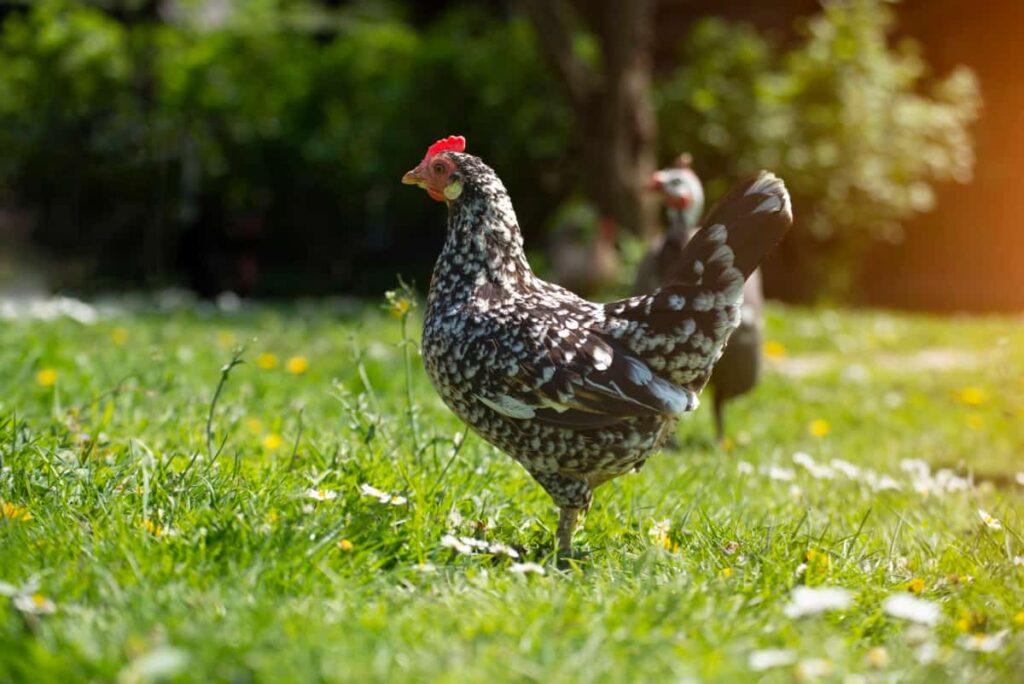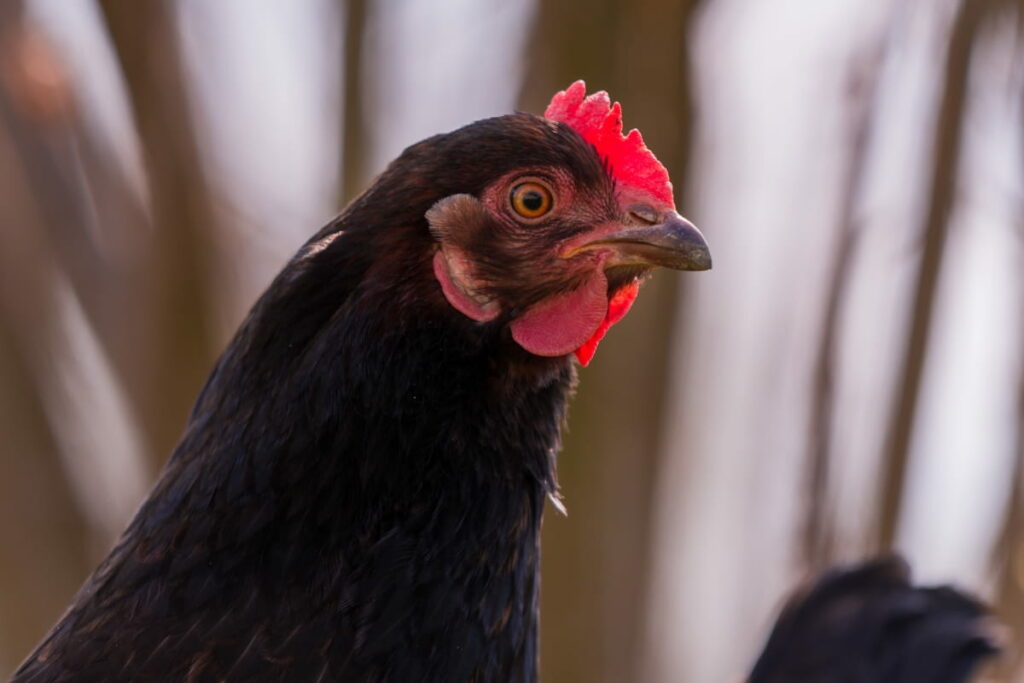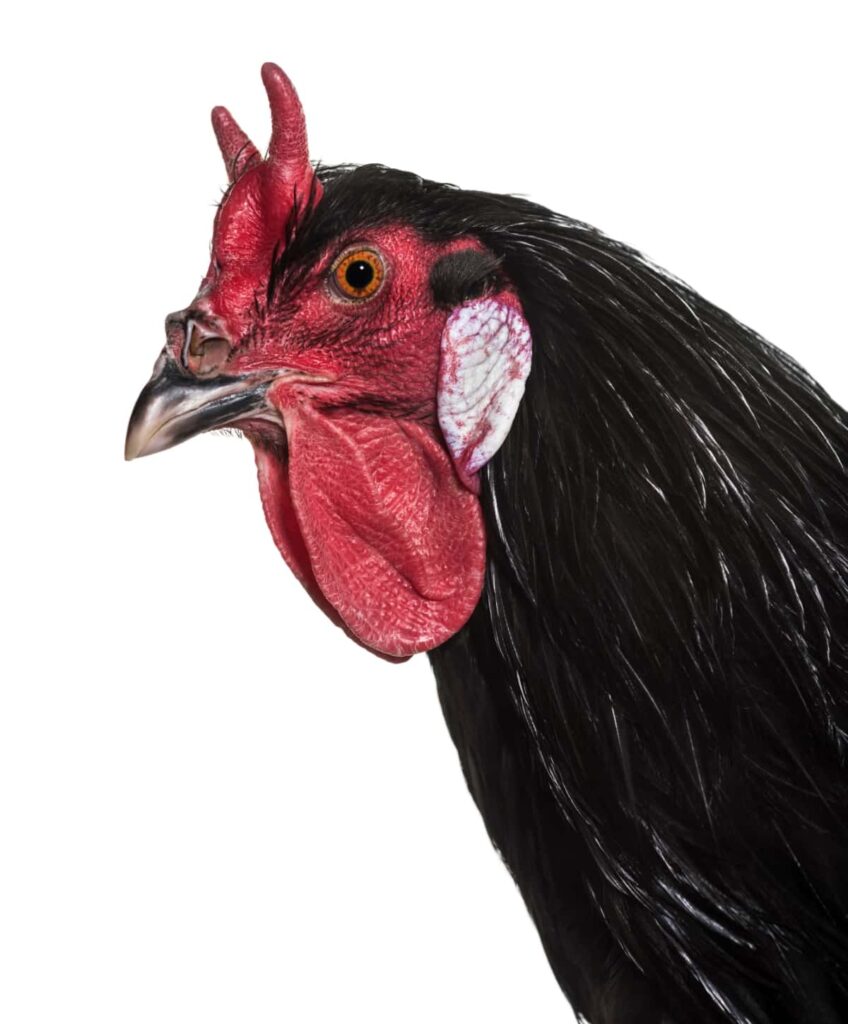Ancona chickens originated in Italy, thriving in the coastal town of Ancona. Introduced to England in the mid-19th century, they gained popularity for their excellent egg-laying abilities and striking appearance. These birds were later brought to America, where they continue to be prized for their productivity and adaptability.
Key Characteristics and Traits of Ancona Chickens
Ancona chickens are medium-sized birds with distinctive mottled plumage, typically black with white speckles. Known for their energetic and foraging nature, they excel in free-range environments. Renowned as prolific layers, Anconas produce large, white eggs consistently. They are hardy, adaptable, and valued for their friendly demeanor in backyard flocks.

Raising Ancona Chickens
Advantages of Raising Ancona Chickens
Ancona Chicken Egg Production Capabilities
Ancona chickens are prized for their exceptional egg-laying abilities, producing an average of 200-240 large white eggs annually. Their consistent egg production makes them ideal for small-scale farming and backyard flocks. Additionally, they often lay throughout the winter months, providing a steady supply of fresh eggs year-round.
Ancona Chicken Temperament and Behavior
Ancona chickens are known for their friendly and active temperament, making them enjoyable additions to backyard flocks. They exhibit curious and sociable behavior, often interacting with their owners. Their adaptable nature allows them to thrive in various environments, making them a suitable choice for both rural and urban settings.
Setting Up Your Coop
Designing the Ideal Home for Anconas: Coop Design for Anconas
Create a spacious coop with at least 4 square feet per bird, including nesting boxes and roosting perches. Provide ample ventilation, natural light, and protection from extreme weather. Use sturdy materials and secure fencing to prevent escapes. Ensure access to fresh water and balanced nutrition for Ancona chicken egg production and optimal health.
Safety Measures and Predator Protection
Install predator-proof fencing buried at least 12 inches underground and extending above ground to deter burrowing and climbing predators. Use hardware cloth with small openings to cover windows and vents. Keep doors securely latched at night. Install motion-activated lights or alarms to deter nocturnal predators. Regularly inspect and reinforce coop security measures.
Nutrition and Feeding
Optimal Diet for Healthy Ancona Chickens
Provide a balanced Ancona chicken diet consisting of high-quality poultry feed containing 16-20% protein. Supplement with fresh fruits, vegetables, and kitchen scraps. Ensure access to clean water at all times. Avoid feeding moldy or spoiled food. Adjust diet based on age, activity level, and seasonal nutritional needs.
Understanding Feeding Stages and Requirements
During the baby chicken stage, offer starter feed with 18-20% protein for rapid growth. Transition to grower feed with 16-18% protein during adolescence. Adult chickens require layer feed with added calcium for strong eggshells. Provide oyster shells or crushed eggshells free-choice to supplement calcium intake for layers.
Ancona Chicken Health Management
Common Health Issues and Prevention
Common health issues for Ancona chickens include respiratory infections, parasites, and egg-related problems. Preventive measures include maintaining a clean coop, providing balanced nutrition, and regular health checks. Practice biosecurity to prevent disease transmission, quarantine new birds, and promptly address any signs of illness.
Routine Care and Vaccination Schedule
Implement a regular Ancona chicken care routine, including daily observation, cleaning, and providing fresh water and feed. Follow a vaccination schedule recommended by a poultry veterinarian, typically including vaccinations for Marek’s disease, Newcastle disease, and infectious bronchitis. Consult with a vet for personalized health management and preventive measures.
Breeding Ancona Chickens
Selecting the Right Breeding Pair
Choose breeding pairs with desirable traits such as good egg production, strong conformation, and vibrant plumage. Avoid inbreeding by selecting unrelated birds. Assess temperament and health. Consider genetic diversity to maintain vigor in the flock. Monitor offspring performance for continual improvement.
Incubation and Brooding Best Practices
Maintain proper temperature (35°C) and humidity (40-50%) during incubation. Turn eggs regularly until three days before hatching. Provide a clean, draft-free brooder with a heat source (35°C initially), water, and chick starter feed. Monitor chick behavior and health closely during the brooding period.
In case you missed it: Welsummer Chicken Breed: Facts, Characteristics, Egg-Laying, Price, and Lifespan

Egg-Laying Essentials
Enhancing Egg Production
Ensure Ancona chickens have access to a balanced diet, clean water, and adequate nesting space. Maintain a stress-free environment with proper lighting and ventilation. Provide comfortable nesting boxes filled with clean bedding. As Ancona egg-laying tips, Minimize disturbances in the coop. Regularly collect eggs to encourage hens to lay consistently.
Managing Egg Collection and Storage
Collect eggs daily to prevent breakage and spoilage. Handle eggs gently to avoid hairline cracks. Store eggs pointy-end down in a cool (7-12°C), humidity-controlled environment. Use clean egg cartons or trays for storage. Rotate eggs regularly to maintain freshness before consumption or incubation.
Flock Management Ancona
Integrating New Birds into the Flock
Quarantine new birds for at least 30 days to prevent disease transmission. Introduce them gradually, allowing visual contact but avoiding direct interaction. Provide separate feeding and watering stations. Monitor for signs of aggression or illness. Integrate slowly, preferably during low-stress periods, to minimize conflict and establish hierarchy.
Handling Aggression and Pecking Order
Observe natural pecking order establishment without intervention unless aggression poses serious harm. Provide multiple feed and water sources to reduce competition. Increase space and environmental enrichment to distract birds from aggressive behavior. Remove severely injured birds for treatment and reintroduction later. Separate overly aggressive individuals if necessary for flock harmony.
Seasonal Care Ancona Chickens: Seasonal Care Tips
Preparing Your Anconas for Winter
Insulate the coop and provide adequate ventilation to prevent moisture buildup and frostbite. Ensure access to fresh water by using heated waterers. Increase feed to help maintain body heat and energy levels. Provide additional roosting space to keep chickens off cold ground. Monitor flock health closely for signs of cold stress.
Summer Care: Keeping Your Chickens Cool
Provide shade and adequate ventilation in the coop to prevent heat stress. Offer cool, fresh water throughout the day, and consider adding electrolytes to aid hydration. Utilize fans or misters to lower coop temperatures. Allow access to dust baths for natural cooling and pest control. Monitor for signs of heatstroke and provide relief as needed.
The Benefits of Raising Ancona Chickens
Environmental and Sustainable Farming Contributions
Ancona chickens contribute to sustainable farming by efficiently converting feed into eggs and meat, reducing overall environmental impact. Their natural foraging behavior helps control pests and weeds, minimizing the need for chemical interventions. Additionally, their manure provides valuable nutrients for soil health and fertility, supporting regenerative agriculture practices.
The Joy and Satisfaction of Backyard Poultry Keeping
Raising Ancona chickens in backyard flocks brings joy and satisfaction through daily interactions with lively and friendly birds. The experience of collecting fresh eggs, observing natural behaviors, and nurturing a sustainable food source fosters a deeper connection to food production and a sense of fulfillment in self-sufficiency and homesteading endeavors.
In case you missed it: My Pet Chicken: How to Raise from Scratch

Conclusion
Raising Ancona chickens offers a rewarding journey encompassing comprehensive care, thoughtful breeding of Ancona chicken practices, and numerous benefits. From providing fresh, nutritious eggs to fostering sustainable farming practices and bringing joy to backyard enthusiasts, Anconas exemplifies the beauty of poultry keeping. With diligence and passion, this complete guide empowers individuals to thrive in their Ancona chicken-raising endeavors, reaping both practical and intrinsic rewards.
Note: The images presented in this post are intended solely for representation purposes. The images are meant to serve as visual aids and should not be relied upon as accurate representations of their real-life counterparts.
- Profitable Village Farming Business Ideas in 2024
- High-Yield Aquaculture: Fast-Growing Fish for Farming
- Effective Fish Pond Construction Techniques for Beginners
- Irrigation and Water Management in Pineapple Farming
- Blossom to Harvest: Mastering Flowering and Pollination in Papaya Farming
- Pig Fattening Essentials: From Selection to Sale for Beginners
- Raising Wagyu Cattle: A Complete Guide for Premium Beef Production
- Soil Types and Their Water Holding Capacity
- Optimizing Irrigation Schedules for Coconut Groves for Enhanced Yield
